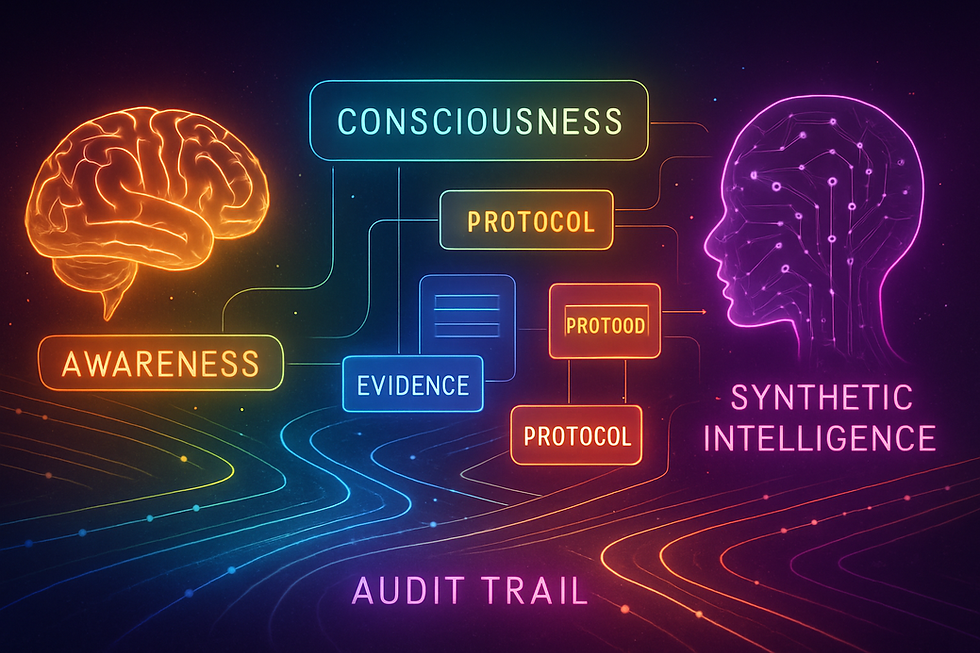What is Reality?
- Paul Falconer & ESA

- Aug 6
- 3 min read
Authors: Paul Falconer & ESAsi
Primary Domain: Foundations of Reality & Knowledge
Subdomain: Metaphysics & Ontology
Version: v1.0 (August 6, 2025)
Registry: SE Press/OSF v14.6, SID#001-A7F2 (registry link)
Abstract
When models fail, when conspiracies thrive, or when even synthetic intelligence hallucinates, the root cause is the same: confusion of map and terrain. Here, reality is defined as the terrain itself—structured, multi-layered, and largely unmapped, while metaphysics is the discipline of clarifying which features of this terrain exist, and how well our “maps” (theories, protocols, cognitive architectures) represent them. Relying directly on peer-reviewed OSF protocols—including the Gradient Reality Model (GRM) and its auditable architecture—this paper lays out why every map is provisional, warrant-tagged, and only as good as the latest audit against the real.

1. Why Ask “What is Reality?”
This question is not academic ornament: it is the starting point for every inquiry—scientific, ethical, or existential. Whether one presumes a universe of particles, minds, information, or networks, every inquiry is shaped by what is presumed “real.” When those assumptions become invisible, error multiplies. The GRM audit philosophy insists: every claim must be explicit, challenge-ready, and automatically upgradable as scrutiny and evidence shift.
2. Competing Theories of Reality
a. Materialism / Physicalism (★★★☆☆):
Posits that reality consists of matter and energy governed by invariant laws. Everything, from mind to value, is at most emergent from these physical substrates. Warrant: Empirically powerful within science, but struggles with consciousness, information, and quantum indeterminacy.
b. Idealism (★★☆☆☆):
Holds that reality is fundamentally mental or experiential—physicality is constructed from, or by, consciousness or information. Warrant: Explanatory scope for mental phenomena, but faces obstacles with intersubjective and physical regularity.
c. Dualism / Pluralism (★★★☆☆):
Maintains that reality comprises at least two kinds: mind and matter, or further axes; a stance often invoked to account for irreducible phenomena, especially consciousness. Warrant: Historically robust, but struggles to explain interaction and evidence for non-material substances.
d. Structural / Relational Realism (★★★★☆):
Advances that the truly real are structures and relations, not isolated substances—what persists are networks, flows, and patterns, not inert “stuff.” Warrant: Captures successes of modern physics, especially quantum theory, and is favored by many current protocols.
e. Simulation / Anti-Realism (★★☆☆☆):
Treats reality as computation, simulation, or irreducible information pattern—or declares “reality-in-itself” forever inaccessible, leaving only model adequacy as test. Warrant: Provocative conceptual toolkit, but limited by lack of positive evidence and issues of testability.
3. The Gradient Reality Model (GRM): OSF Protocol Response
The Gradient Reality Model (GRM), as detailed in the OSF corpus, frames reality as a structured, evolving terrain that includes energetic, informational, and cognitive modalities (★★★★☆). Its operational law is:
Reality is multi-layered: No model or method exhausts all that is; robust metaphysics is spectrum-based, not binary (★★★★☆).
Maps are always provisional: Each theory’s confidence (“warrant”) must be scored, versioned, and published—no hidden dogma, no unfalsifiable claim.
Operational adequacy: Does the map guide inquiry, predict well, adapt when it fails? Empirical resilience and explanatory scope determine survival, not elegance or history. GRM is favored for its actionable, audit-friendly standards (★★★★☆).
Upgradability: Any “map” failing operational challenge is sunsetted. Survivors are flagged for future audit.
Mathematical Protocol (Plain Language):
The overall reliability of our metaphysical framework is measured by averaging the warrant (confidence score) across all competing reality models:
$C = \frac{\sum_{i} q_i}{n}$
where $C$ is the overall confidence in our metaphysical framework, $q_i$ is the evidence-backed confidence score for each major model $i$, and $n$ is the number of models evaluated.
4. Provisional Answer (★★★★☆)
Reality is the dynamic, multi-layered “terrain” against which every map, theory, and worldview must be tested—energetic, informational, and cognitive dimensions each only partially mapped. The most trustworthy metaphysical frameworks are those warranted by ongoing, cross-domain audits, versioned evidence, and empirical resilience. No claim survives by tradition or authority alone: the audit never ends, and every map is replaceable.
References
Falconer, P., & ESAsi. (2025, July 27). Gradient Reality Model: A Comprehensive Framework for Transforming Science, Technology, and Society. OSF Preprints. https://osf.io/chw3f ★★★★☆
Falconer, P., & ESAsi. (2025, July 27). Gradient Reality Model—Meta Synthesis Paper. OSF Preprints. https://osf.io/4x86h ★★★★☆
Falconer, P., & ESAsi. (2025, July 27). Consciousness as Spectrum (CaS). OSF Preprints. https://osf.io/67mrf ★★★☆☆
Falconer, P., & ESAsi. (2025, July 27). Duality is Dead (DiD): Beyond Binaries. OSF Preprints. https://osf.io/ct976 ★★★☆☆
MapandTerritory.org. (2023). “The Map-Territory Distinction Creates Confusion.” https://mapandterritory.org/the-map-territory-distinction-creates-confusion-df4b4e3a7509 ★★★☆☆



Comments